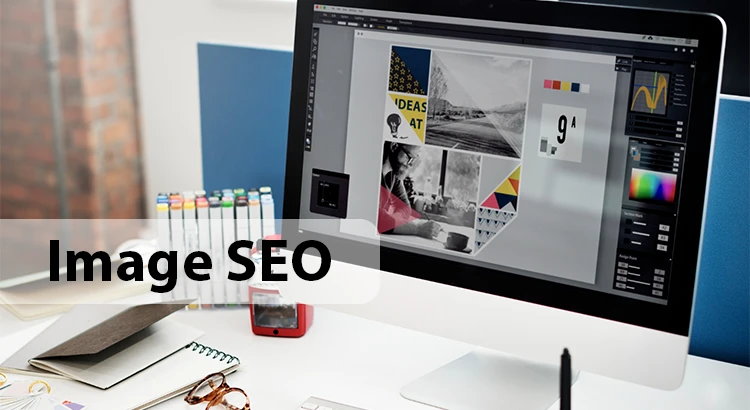Effective image SEO strategies are essential for improving your website’s visual content visibility. Integrating these practices into your on-page SEO efforts helps enhance both user experience and performance in visual search results. This article outlines practical techniques to help your images rank better and support overall site performance.
What Is Image SEO?
It is the process of enhancing images on your website to help them and the pages they belong to appear more prominently in organic search results. As a result, these improvements can drive additional traffic to your website.
Some of the most widely used image optimization techniques include:
- Adjusting image size and compression
- Using clear, descriptive file names
- Providing relevant alternative text
This form of optimization helps search engines like Google identify, interpret, and categorize visual content more accurately. That increases the likelihood of your images appearing in relevant search results.
Efficiently optimized visuals also improve load speed and enhance how users interact with your content. These are both key ranking factors in how search platforms assess and order results.
Why Is Image SEO Important?
Improving the visibility of your visual assets allows them to appear in various search result types, including the main search listings, Google Images, and Google Lens results. These placements are valuable, as they attract user attention and encourage clicks.
Many people bypass traditional searches altogether and head directly to visual-based search tools. With billions of monthly queries on platforms like Google Lens, ensuring your visuals are correctly optimized allows you to tap into this user behavior.
In addition, visuals often appear within the primary search results themselves. A well-optimized image can act as an eye-catching feature, encouraging more engagement with your page.
It’s also important to note that optimizing images contributes to better overall page performance, which in turn supports broader site visibility.
How to Optimize Images for SEO?
Apply these image optimization best practices to make your website more search engine friendly and enhance the user experience.
1. Find or Create Useful Images
The first step in optimizing visual content is selecting or designing imagery that aligns with your page goals. For instance:
- Photos can highlight products or break up text-heavy pages
- Custom graphics can illustrate abstract concepts
- Charts and graphs help explain complex data clearly
- Icons improve navigation and overall site usability
- Logos reinforce brand recognition
- Screenshots assist in tutorials or walkthroughs
Whenever possible, create your own visuals. Unique assets add value and encourage better visibility in search results. If you must use existing media, ensure you have the appropriate rights to avoid copyright infringement.
2. Choose the Right Image Formats
You can save or convert image files into a variety of formats based on how you plan to use them.
SVG is ideal for icons and logos because it can be resized without losing quality. It also works well with web technologies like JavaScript and CSS, making it highly flexible for interactive elements.
WebP is one of the most efficient formats for general-purpose visuals. It offers several advantages:
- Supported by major browsers, search engines, and social media platforms (though not compatible with some older systems)
- Typically produces smaller file sizes, which helps pages load faster
- Supports transparency and animation
- Offers both lossy and lossless compression, making it easier to balance file size and image clarity
That said, both SVG and WebP files can be more complex to create and manage than traditional formats.
Good fallback options include:
- JPEG for regular photos or standard graphics
- PNG for visuals requiring transparency, embedded text, or intricate details
- GIF for basic animations or looped visual elements
3. Give Your Images Descriptive File Names
Search engines use image file names to better understand what the image contains. So it’s important to name your files clearly and briefly before uploading them.
Use relevant keywords that describe the image, and avoid long, keyword-stuffed names or generic file names from cameras or downloads.
Examples:
- Correct: samsung-galaxy-s25-black-front-view.jpg
- Incorrect: samsung-galaxy-s25-latest-flagship-smartphone-black-color-front-camera-display-2025-release.jpg
- Incorrect: IMG_2087.jpg
If you’re using the same image on localized pages, update the file name to match the language of each version.
For example:
Use samsung-galaxy-s25-noir-face-avant.jpg for a French version of the page.
This helps improve search visibility in different regions and ensures better indexing for translated content.
4. Add Descriptive Alt Text
Alt text is a short written description of an image included in a webpage’s code. It’s stored in the alt attribute of the image tag, like this:
<img src=”image-file-example.jpg” alt=”Alt text goes here”>
Its primary purpose is accessibility. Screen readers use alt text to describe images to users who are visually impaired. It also displays when an image fails to load.
Alt text supports image-based website optimization as well. Search engines rely on this attribute to understand what each image shows.
Follow these best practices when writing alt text:
- Only add alt text to meaningful, functional images. Skip decorative elements that don’t add information.
- Describe what’s important in context. If you use the same image in multiple places, tailor the description to match the purpose each time.
- Keep it concise—ideally under 125 characters. Some screen readers stop reading after that limit.
- Place key information in captions or body text, not the alt text. That way, it’s visible to all users.
- Don’t include phrases like “image of” or “photo of.” Alt text already implies it describes an image.
5. Resize Images
Reducing the dimensions of your images can significantly improve page loading speed—without sacrificing quality.
In most cases, website images don’t need to be wider than 2,500 pixels. But the ideal size depends on several factors:
- Container size: An image doesn’t need to be larger than the container it’s displayed in. Check the maximum width of the container in your layout.
- Purpose of the image: Large product photos may need higher resolution for zooming and detail, while smaller elements like thumbnails can use much lower dimensions.
- Devices used by your audience: Tools like Google Analytics 4 can show what screen resolutions your visitors use, helping you choose the right image sizes.
You can resize images easily with tools like Photoshop or other editing software. Some website platforms also offer plugins that automatically scale images when you upload them.
6. Compress Images
Image compression reduces file size while preserving visual quality, helping your pages load faster.
There are many tools and plugins available that let you compress images manually or automatically. Whatever tool you use, you’ll typically need to configure the following settings:
| Setting | Description | Recommended Setting |
| Lossy vs. lossless | Lossy compression removes non-essential data to reduce file size. Lossless compression keeps all original data but typically results in larger files. | Lossy |
| Quality factor | For lossy compression, you can usually set a quality value from 0 to 100. Higher values mean better quality and larger file sizes. | 75–85 |
| Resolution | Often shown as pixels per inch (PPI) or dots per inch (DPI). Higher resolution means better quality but larger files. | 72 DPI |
Use a balance of these settings to keep your images sharp while reducing loading times.
7. Use Responsive Image Scaling
Responsive scaling ensures that visuals automatically adjust to fit different screen sizes. It prevents them from appearing oversized on mobile or too small on desktops.
This enhances both user experience and performance. CSS is typically used to implement responsiveness. Some content management systems apply it by default; otherwise, plugins or developer assistance may be necessary.
8. Implement Lazy Loading
Lazy loading delays the loading of images until they appear in the user’s viewport. This reduces initial page load time by focusing only on content above the fold (the visible part of the page before scrolling).
The simplest way to enable lazy loading is by adding the loading=”lazy” attribute to your image tags. For example:
<img src=”example.jpg” loading=”lazy” alt=”Alt text”>
Only apply lazy loading to images that appear below the fold on all device types. If you add it to above-the-fold images, it can actually slow down your page instead of speeding it up.
9. Create an Image Sitemap
An image sitemap is an XML file that highlights visuals you want search engines to crawl and index.
This ensures that none of your important visual assets are overlooked during site crawling. It’s especially useful if your media is loaded via JavaScript or isn’t included in a regular sitemap.
10. Use a Content Delivery Network
A content delivery network (CDN) stores your assets on multiple servers worldwide, delivering them from the one nearest to each user for faster load times.
To implement a CDN:
- Choose a provider like Cloudflare or Amazon CloudFront
- Integrate it with your platform
- Upload visuals to the CDN
- Adjust DNS settings and HTML references accordingly
- Update your image sitemap to reflect new URLs
Developer support is usually needed to complete this setup.
11. Enable Browser Caching
Browser caching allows a visitor’s browser to store files like images for a set period. This way, when the same files are needed again, they load more quickly without being re-downloaded.
For example, when a new visitor lands on your homepage:
- If your site logo is cached for 365 days, it will load faster when the visitor browses other pages or returns to your site later in the year.
- If it isn’t cached, the browser must download the image every time it’s needed. This increases bandwidth usage and puts more load on your server.
Since images typically don’t change often, they can usually be cached for extended periods without issues.
12. Apply On-Page SEO Best Practices
On-page optimization helps your pages rank higher in search results and can improve image visibility as well.
Start with a clear, descriptive title tag. Search engines use it to understand your page and display it as the clickable headline.
Also write an effective meta description, which may appear below the title in search listings.
To avoid your text being cut off, keep title tags between 50–60 characters and meta descriptions around 105 characters.
13. Add Structured Data
Structured data, or schema markup, adds context to your content and improves how it appears in search results. It can also help your images show up as rich snippets with enhanced visual elements.
You can use structured data to specify images for articles, events, products, and organizations. The ImageObject schema allows you to provide additional details like the image creator’s name, copyright information, and license URL.
Adding this code to your pages increases the chances of your content appearing with image previews or other enhanced features.
14. Optimize Open Graph Meta Tags
Open Graph meta tags control how your content looks when shared on social platforms like Facebook, LinkedIn, and X (formerly Twitter).
To ensure your page previews look appealing and informative, include these four key Open Graph properties:
- og:title – the title shown in the preview
- og:type – the content type, such as “article”
- og:image – the image URL to display
- og:url – the page’s canonical URL
Summary
Effective image search engine optimization improves website performance by using the right formats, compressing files, adding descriptive alt text, and implementing lazy loading. These practices help images load faster, enhance accessibility, and increase visibility in search results.


